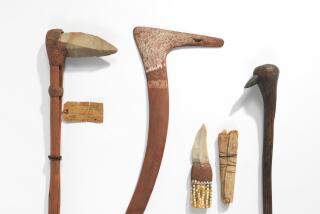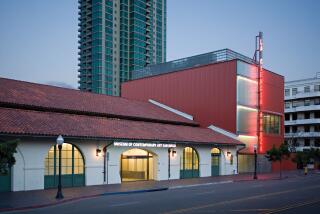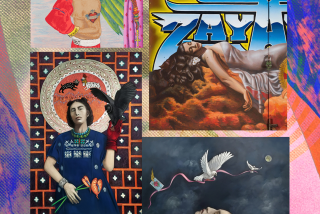Many faces of culture
OF the 150,000 or so non-Western objects and artifacts housed in UCLAâs Fowler Museum, among the most well known is a late 19th century wooden mask from the Bamileke people of Cameroon. Although the mask has an imposing quality (it was used in rituals honoring leaders in Bamileke society), its most prominent features by far are its oversized ears, earning it the nickname âMickey.â
Though âMickeyâ has traveled the world as part of the Fowlerâs tradition of temporary exhibitions, it wonât, as it turns out, be going anywhere soon.
The mask, along with 250 other highlights from the Fowlerâs permanent collection, is part of the 14-year-old museumâs first long-term exhibition, âIntersections: World Arts, Local Lives.â Four years in the making, the $1-million project showcases objects from African, Native and Latin American, and Asian and Pacific peoples, dated between the first millennium BC and the present. The show is slated to be up for at least the next seven to 10 years.
âThe new long-term exhibition is really a brand-new initiative for us, and itâs an anchor for the institution that says who we are without us even having to explain it,â says Fowler Director Marla Berns. âNow people can walk into the gallery and really get a deep introduction to world art that can ground them and allow them to understand the temporary exhibitions that will continue to be featured in other parts of the museum in a more meaningful way.â
Visitors to the Fowlerâs 5,600-square-foot Joss Gallery will first be greeted by five striking representations of human faces: a mask embellished with snail shells and plant fiber from the island of New Ireland in Papua New Guinea; a portrait vessel by the Moche people from the north coast of Peru; a Chinese hand puppet known as the blind scholar, featuring passages from a textbook inscribed up and down its neon-yellow face; a harlequin-like mask decorated in red, orange and black pigments from the Tsimshian people of British Columbia; and a headdress sprouting a trio of elaborate horns from the Efut people of Nigeria.
Though these objects were selected as emblematic of the Fowler collectionâs major geographical regions, the museumâs deputy director and chief curator, Polly Roberts, says the exhibition isnât so much about specific places or people as it is about the ideas that have brought them together in the same place.
âIn the past 30 years, the trend in the display of non-Western art has been to do it geographically -- one room for Africa, a section dedicated to Asia and the Pacific, and a section dedicated to the Americas,â Roberts says. âA collection like ours, however, goes beyond the boundaries of clear-cut regions -- we have a Yemenite necklace and an Uzbekistan coat from Central Asia in the show -- and as a result, we felt there were ways we could comment cross-culturally.
âWe also wanted people to think about what the cultures share and the similar challenges they face, but also note the very different aesthetics and artistic solutions that people find to deal with the same kinds of things.â
To that end, the exhibition is divided into four major thematic sections: âArt and Action,â which looks at the relationship between an objectâs form and function; âArt and Knowledge,â which examines the ways art conveys knowledge and communicates history; âArt and Power,â which shows artâs role in defining and asserting status and prestige; and âArt and Transformation,â which deals with art as it pertains to personal and societal transitions.
Each section also showcases some of the Fowlerâs best-known objects. Among the highlights in the âArt and Actionâ section is an 18th or 19th century nkisi nkondi, a wooden figure by the Yombe people from the Democratic Republic of Congo. It is embedded with nails and shards of cloth meant to awaken spirits and attest to oaths sworn in legal proceedings.
In the âArt and Powerâ section, one of the marquee pieces is a colorful and intricately carved hornbill from the 19th century. The Iban people of Malaysia consider hornbills to be omen birds, and the warring cult would raise the hornbill figures into the sky atop tall poles before they were metaphorically sent to destroy the enemy.
Although the selection of objects such as the nkisi nkondi and the hornbill was a given, Berns and her team didnât want the exhibition to just be a treasure show. Each section features objects grouped by region or cross-culturally by sub-theme. One sub-theme, âMemory and Cosmology,â is in the âArt and Knowledgeâ section, where a North Australian bark painting that depicts the founding of a clan is displayed with a buffalo bone thatâs inscribed with an alphabetic writing system used by the Batak people of Sumatra.
âHere you have works of art from different parts of the world that help people remember their history and that record aspects of their cosmology through graphic symbols and different kinds of writings,â Roberts says. âAll these things are in the same case, so you see an idea in cross-cultural comparison.â
Though most of the objects are on long-term display, âIntersectionsâ hasnât completely abandoned the museumâs custom of changing exhibitions. Located in the heart of the new exhibition is a gallery-within-a-gallery titled âFowler in Focus,â which is dedicated to rotating installations. The first installation features 50 highly detailed Indian oil lamps and incense burners. Up next is an exhibit of 24 Zambian masks.
âThe exhibits will change every four months and will highlight subsets -- sometimes recent donations, sometimes just an exploration of a particular theme or interest to our curators, but always drawn from our own collection,â says Roy Hamilton, the Fowlerâs curator of Asian and Pacific Collections. âItâs a way to keep the long-term exhibition fresh and dynamic, and itâs a great way to get more of the collection out.â
*
âIntersections: World Arts, Local Livesâ
Where: Fowler Museum at UCLA, Westwood
When: noon to 5 p.m. Wednesdays through Sundays, noon to 8 p.m. Thursdays
Ends: runs indefinitely
Price: free
Info: (310) 825-4361, www.fowler.ucla.edu
More to Read
The biggest entertainment stories
Get our big stories about Hollywood, film, television, music, arts, culture and more right in your inbox as soon as they publish.
You may occasionally receive promotional content from the Los Angeles Times.










